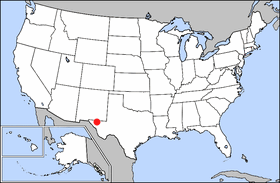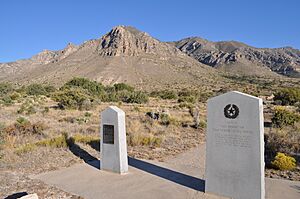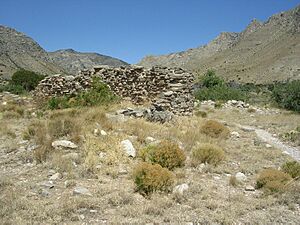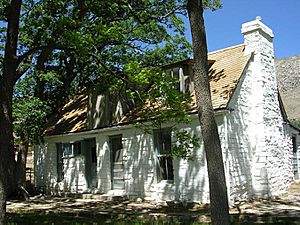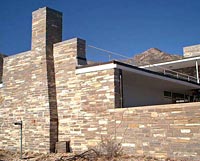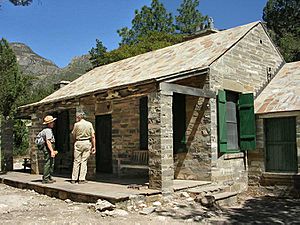National Register of Historic Places listings in Guadalupe Mountains National Park facts for kids
Guadalupe Mountains National Park in Texas is a special place, not just for its amazing mountains and deserts, but also for its history! Many important places within the park are listed on the National Register of Historic Places. This is like a special list kept by the United States government to protect and celebrate places that are important to American history, architecture, archaeology, engineering, or culture. When a place is on this list, it means it's recognized for its historical value and efforts are made to preserve it for future generations.
In Guadalupe Mountains National Park, there are two large areas (called "districts") and four individual spots that are on this important list. These places tell stories about early travel, ranching, and how people lived in this rugged part of Texas long ago. Let's explore some of these cool historic sites!
Contents
Historic Places in Guadalupe Mountains National Park
The Butterfield Overland Mail Corridor
Imagine a time before emails, phones, or even trains! How did people send messages and goods across the country? One way was by stagecoach! The Butterfield Overland Mail Corridor was a very important route for mail and passengers in the mid-1800s. It stretched all the way from Missouri to California. A part of this historic trail runs right through Guadalupe Mountains National Park.
This corridor helped connect the eastern and western parts of the United States. It was a tough journey, crossing deserts and mountains. The people who traveled and worked on this route faced many challenges. The corridor in the park includes a famous stop called Pinery Station, which we'll learn more about next. This historic route reminds us how challenging communication and travel used to be.
Pinery Station
Pinery Station was a vital stop along the Butterfield Overland Mail route. It was built in 1858 and served as a place where stagecoaches could change horses, and travelers could rest and eat. Imagine how tired people must have been after days of bumpy travel!
The station was a simple stone building, but it was a welcome sight for those crossing the vast wilderness. Today, you can still see the ruins of Pinery Station, which give us a glimpse into what life was like for travelers and mail carriers over 160 years ago. It's a great example of how people adapted to the harsh conditions of the desert to keep communication flowing.
Frijole Ranch
The Frijole Ranch, also known as Guadalupe Ranch, is another fascinating historic site within the park. This ranch was established in the early 1900s and was one of the first permanent settlements in the Guadalupe Mountains. It shows us how early settlers lived and worked in this area.
The ranch house and other buildings tell the story of a self-sufficient way of life. Families here had to be resourceful, growing their own food and raising livestock in a remote environment. Today, the Frijole Ranch is preserved by the National Park Service and helps visitors understand the history of ranching and settlement in the region. It's a great place to imagine what life was like for pioneer families.
McKittrick Canyon Archeological District
The McKittrick Canyon Archeological District is a very special area because it holds clues about people who lived in this region thousands of years ago. Unlike the other sites that tell stories from recent history, this district is about ancient cultures.
Archaeologists study this area to learn about the early inhabitants, including Native American groups, who used the canyon for shelter, hunting, and gathering food. They find artifacts like tools, pottery, and remnants of old campsites. Because these sites are so fragile and important for understanding the past, their exact locations are kept secret to protect them. This district helps us understand the very long history of human presence in the Guadalupe Mountains.
Wallace E. Pratt House
The Wallace E. Pratt House is a unique home built by Wallace E. Pratt, a famous geologist who loved the Guadalupe Mountains. He was one of the first people to explore and understand the geology of this area, especially the amazing McKittrick Canyon.
Pratt built this house in the 1930s. It's sometimes called the "Ship on the Desert" because of its unusual design that blends into the landscape. Pratt later donated much of his land, including McKittrick Canyon, to become part of Guadalupe Mountains National Park. His house is a reminder of his important contributions to geology and conservation.
Wallace Pratt Lodge
Another property connected to Wallace E. Pratt is the Wallace Pratt Lodge. This lodge is located deeper inside McKittrick Canyon, at the spot where two branches of the canyon meet. It was a more rustic retreat for Pratt and his guests.
The lodge allowed Pratt to spend more time exploring and studying the canyon, which he deeply cherished. Both the house and the lodge show Pratt's deep connection to the land and his desire to live in harmony with nature. These buildings are important because they represent the personal story of a man who played a key role in protecting this beautiful national park.


